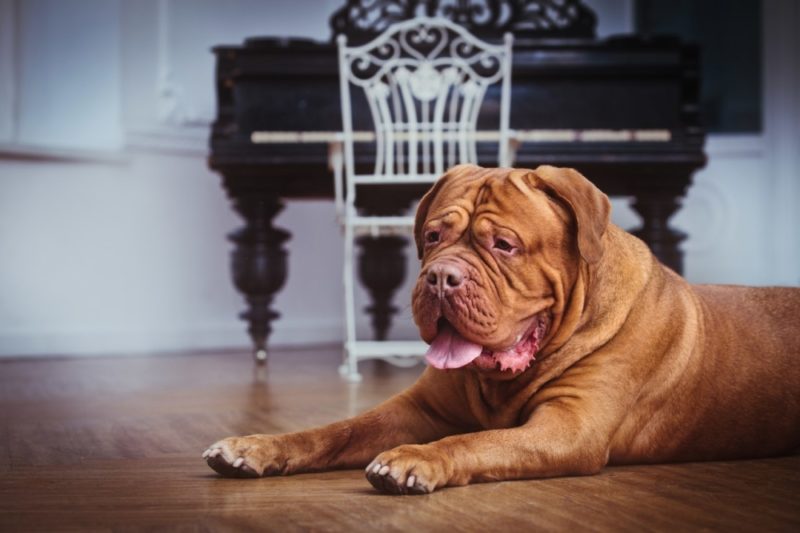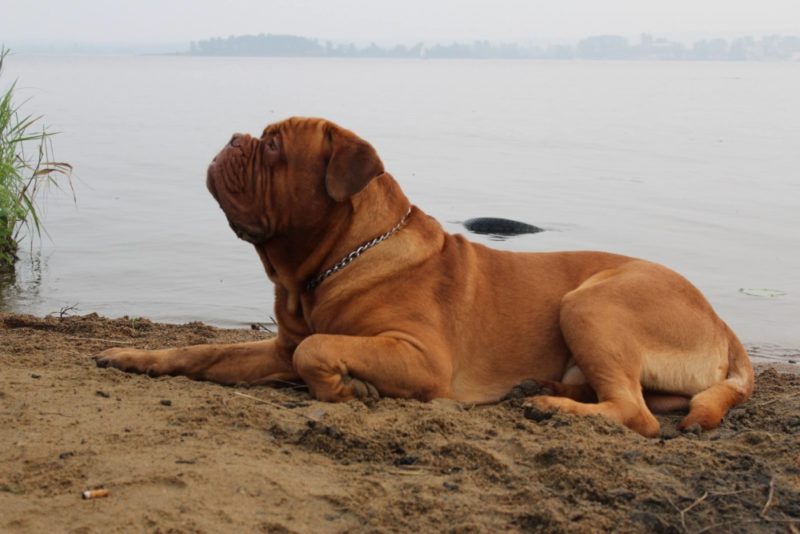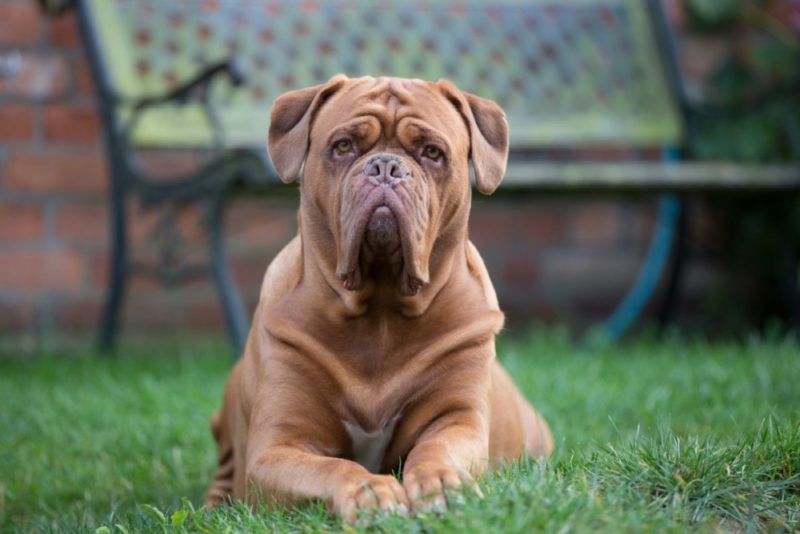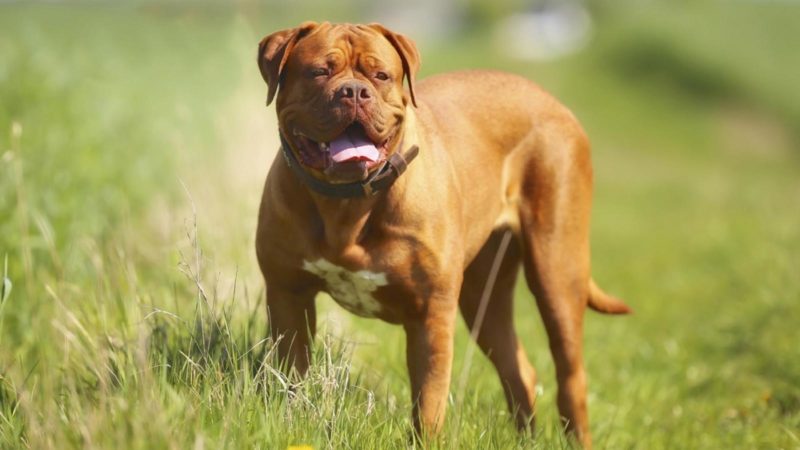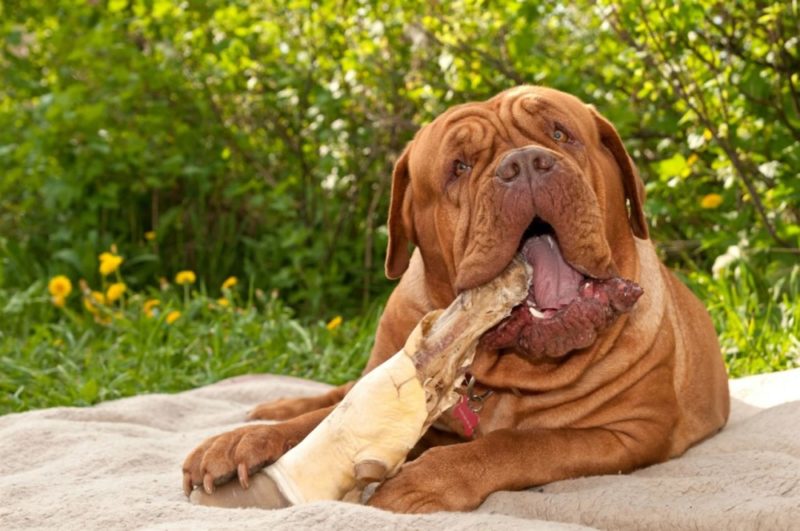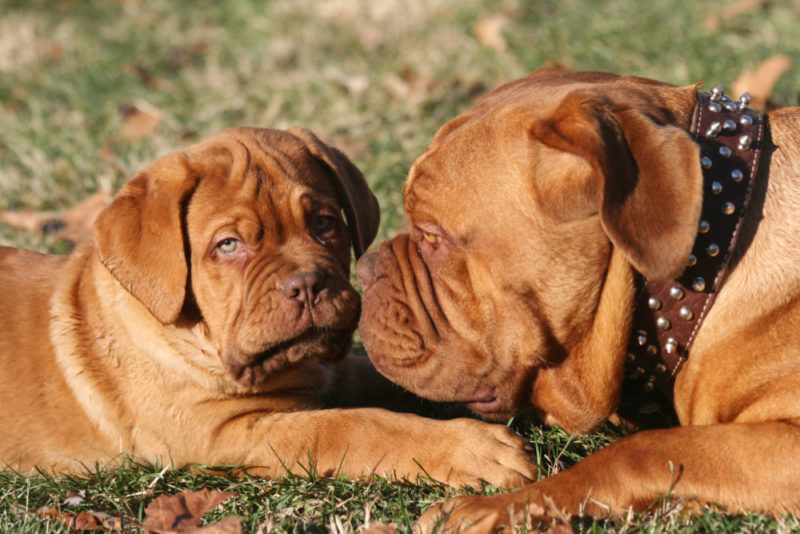French Mastiff is a dog with an extensive and interesting biography. Having survived the revolution and the years of the First World War, being fighting dogs, these dogs today are devoted advocates and companions of man. What are the benefits of dogs of this breed?
Material Content:
Description and characteristics of the breed
The French mastiff or, as it is also called, the Bordeaux mastiff is a massive, muscular dog that gives the impression of brute force.
And indeed, their impressive figure is capable of inspiring fear on any intruder. Description of the breed is appropriate to start with a mention of the working qualities of the dog. So, these animals are recognized as excellent guards, fighters and hunters.
A somewhat frightening appearance in the case of the French mastiff does not match the character of the dog. These powerful four-legged pets are sociable and balanced creatures, characterized by constant good nature, calmness and loyalty to the owner. In communication with humans, these dogs behave exclusively intelligent (of course, if the two-legged is not trying to encroach on its territory).
Origin history
The French mastiff is a direct descendant of the ancient Molossians. Some researchers are confident that the Great Dane of Bordeaux came from the Great Dane. The administrative center of this French province is the city of Bordeaux, which determined the middle name of the mastiffs.
The livestock of these animals decreased significantly during the years of the French Revolution. These noble creatures were exterminated along with their wealthy masters, since the dogs were considered a symbol of luxury.A small number of French mastiffs were exported abroad, and only this did not allow the breed to break off. By the end of the 19th century, Bordeaux dogs became a real rarity in France. Some modern researchers believe that purebred individuals of this breed were preserved exclusively in the Pyrenees on the border with Spain.
The wave of popularity swept the mastiffs in 1863. The Bordeaux mastiff Magent helped to gain fame for the breed. It was he who won the championship at the Paris Dog Show. Over time, the dogs became popular all over the world, but only came to Russia at the end of the 20th century.
French Mastiff breed standard
French mastiff breed standards include the following requirements:
- The weight of Bordeaux dogs varies from 45-50 kg, the height at the withers is 57-65 cm
- The head is large, with deep folds of skin extending from the forehead.
- The neck is strong, short.
- Ears are hanging, small in size.
- Oval eyes have a dark brown or hazel tint.
- The jaws are powerful, wide.
- The chest is deep and strong.
- The tail is long, thick at the base. Even in working condition, having risen, he should not twist and throw on his back.
The classic color of Bordeaux dogs is all shades of red. White spots on the tips of the paws and chest are not considered marriage.
Dog's purpose
From ancient times, French mastiffs guarded the private possessions of people and pets, and were also used as hunters of large predators. There is evidence that the Bordeaux dogs took part in dog battles. In addition, mastiffs became extremely popular with butchers who used them to transport meat carcasses by harnessing dogs to carts.
Despite all its rather aggressive functionality in the past, today the French mastiff is an excellent companion for the family. The loyalty and good nature of this dog helps her steadfastly endure all the pranks of children, without causing them the slightest harm. In general, these dogs tend to take custody of any creature that is weaker than them, whether people or animals.
Maintenance, care and feeding
Dogs get along well in an apartment and a private house, but they should be kept in an aviary exclusively in the summer. A short coat is not able to protect these animals from frost. Also, you should not keep the Bordeaux dogs on the chain: for outgoing dogs, lovers of human society, this will be a heavy blow. Animals living in the apartment should be systematically walked. After the promenade, the mastiff will sleep peacefully in the space allotted to him.
Walk the dog and give her food twice a day. At the same time, the walk should not be shorter than 1-2 hours. Being on the street, the mastiff must be kept on a leash. These animals cannot be limited in movement, but should not be overloaded with physical exercises either.
Advice! French mastiff puppies under 1 year old should be protected from excessive physical activity in order to avoid joint problems.
Despite the size, the French mastiff eats a little - at a time it is enough for him to eat 200 g of feed. Puppies eat 3 to 5 times a day, by the year switching to two meals a day. The menu should be balanced and include various useful additives. Ready food, as a rule, already contains all the necessary elements. But if the animal is breastfed, food should be varied with various trace elements and minerals. Special complexes can be purchased at veterinary pharmacies. It is useful to give chalk to puppies in order to strengthen the bone structure.
Breeders mainly feed their pets with balanced feed. Veterinarians recommend a mixed diet for French mastiffs. In other words, in addition to the finished feed, they can be treated with natural products: beef (raw), offal, cartilage. Be sure to include cottage cheese, eggs, fish, vegetables in the diet of mastiffs. It is permissible to cook porridge with the addition of meat, vegetables.
As for the mastiff hair, it does not require specific care, since it is too short. The dog can be combed with a brush, paying particular attention to this procedure during the molting process, which occurs twice a year.
If the animal’s claws do not grind on their own, they should be cut with a clipper. Fast claw germination is characteristic of dogs that move little on hard ground.
After walking along the street, the mastiff should wash its paws and always face, because dust and dirt can accumulate in the folds of the skin. Mastiffs are big fans of water procedures, so you should bathe them at least once a month (more often in summer).
Pros and Cons of Dogue de Bordeaux
The main advantages of the Bordeaux dog are:
- intelligence;
- kindness;
- learning ability;
- courage;
- devotion;
- balanced temperament;
- convivial disposition;
- grace and beauty.
The breed is also characterized by disadvantages, among which:
- difficulty in caring for skin folds;
- possible aggression shown to other large animals;
- high cost of puppies.
The French mastiff is a charming giant, getting along well within a private house or apartment. These dogs are excellent guards and bodyguards. However, these good-natured giants are selfless devotion, loyalty to their family and can even act as attentive woolen nannies.


